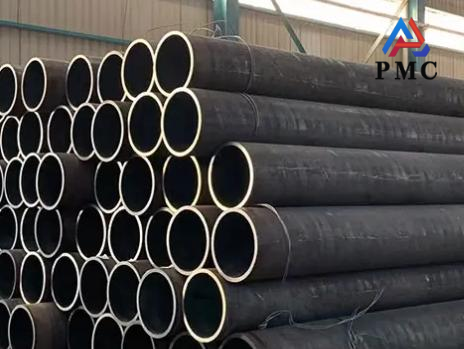
Commonly Used Seamless Pipe Materials and Uses
Seamless pipe is a type of pipe manufactured without any welded joints, offering a smooth and continuous structure throughout its length. Made from solid round steel billets that are heated and then pierced to form a hollow tube, seamless pipes provide excellent strength, uniformity, and resistance to pressure and corrosion. They are widely used in industries such as oil and gas, power generation, petrochemical, and mechanical engineering where high performance and reliability are critical.
Commonly used seamless pipe materials and uses
Seamless pipes are widely used in various industrial and civil fields due to their characteristic of having no welds. Their main advantages are higher strength, better sealing, more uniform mechanical properties and higher reliability. The following is a careful summary of 6 commonly used seamless steel pipes and their main applications.
1. Seamless pipe for fluid transportation
This is the most common type of seamless pipe, mainly used for conveying various fluid media.
Common Materials
Carbon steel: 20# (Chinese grade, equivalent to a portion of ASTM A106 Gr.B or A53 Gr.B), Q235B (ordinary carbon structural steel), and Q345B (low-alloy, high-strength structural steel). These grades offer excellent weldability and ductility, and are relatively cost-effective.
Main Applications
Water, oil, gas, and steam pipelines: Widely used in long-distance transmission pipelines and process piping within industrial plants in industries such as petroleum, natural gas, chemicals, electric power, and municipal construction.
Fire protection pipes: In fire protection systems, seamless steel pipes that meet fluid transportation standards are also commonly used (usually with anti-corrosion treatments such as plastic coating or galvanizing).
Implementation Standards
Mainly based on the national standard GB/T 8163.
2. Seamless pipe for structure
This type of steel pipe is mainly used for general structures, mechanical structures and load-bearing components.
Common materials
Carbon steel: 10#, 20#, 35#, 45# (hardness and strength increase as carbon content increases).
Low-alloy steel: Q345B, etc.
Main applications
Building structures: as supporting columns, frames, trusses, etc.
Mechanical manufacturing: used to manufacture mechanical parts such as shafts, sleeves, connecting rods, frames, and brackets.
Bridges, vehicles, and ships: used as structural parts.
Implementation standards
Mainly based on the national standard GB/T 8162.

3. Seamless pipes for boilers
According to the pressure level of the boiler, it can be divided into low- and medium-pressure boiler tubes and high-pressure boiler tubes, which have strict requirements on high temperature resistance and pressure bearing capacity.
Seamless pipes for low and medium pressure boilers
Commonly used materials: 10#, 20# (20G is 20# steel specially used for boilers).
Main uses: manufacturing superheated steam pipes, boiling water pipes, large smoke pipes, small smoke pipes, etc. for low and medium pressure boilers.
Implementation standard: Mainly based on national standard GB/T 3087.
Seamless pipes for high-pressure boilers
Commonly used materials: 20G, 12Cr1MoVG, 15CrMoG, P11, P22, P91, P92 and other alloy steels.
Main uses: manufacturing high pressure and above water tube boiler heating surfaces, economizers, superheaters, reheaters and high temperature and high pressure pipelines in the petrochemical industry.
Features: Excellent high temperature endurance strength, creep resistance and oxidation resistance.
Implementation standard: Mainly based on national standard GB/T 5310.
4. Seamless pipe for petroleum cracking
This type of steel pipe is used in the oil refining process and needs to withstand high temperature, high pressure and complex corrosive environment.
Common materials
10#, 20#, 12CrMo, 15CrMo, 1Cr2Mo, 1Cr5Mo, etc.
Main Applications
Petroleum cracking tubes, heat exchanger tubes, pipelines, etc.
Features
In addition to high temperature and high pressure, resistance to hydrogen sulfide corrosion, carbon deposits, and intergranular corrosion must also be considered.
Implementation Standards
Mainly based on the national standard GB/T 9948.
5. Precision seamless pipe
These steel pipes are produced by cold drawing or cold rolling processes and have extremely high dimensional accuracy and surface finish.
Common Materials
10#, 20#, 35#, 45#, 20Cr, 40Cr, etc.
Main Applications
Hydraulic Systems: Hydraulic cylinders, cylinder barrels, and precision hydraulic piping.
Automotive Industry: Fuel lines, brake lines, and hydraulic booster hoses.
Instruments: Precision instruments and piping in automation equipment.
Mechanical Components: Mechanical parts requiring high dimensional accuracy and surface quality.
Implementation Standards
Mainly based on the national standard GB/T 3639.
6. Stainless steel seamless pipe
This type of steel pipe is known for its excellent corrosion resistance.
Common Materials
304/304L, 316/316L (the L represents low carbon, which improves intergranular corrosion resistance), 321, and 347.
Main Applications
Chemical, Food, and Medical: Transporting corrosive media and fluids requiring high hygiene standards (such as drinking water and pharmaceuticals).
Marine Engineering: Seawater desalination and offshore platform pipelines.
Special Industries: Applications requiring both high-temperature and corrosion resistance.
Implementation Standards
Typically, international standards such as ASTM A312 and ASTM A213 are followed, with corresponding national standards also being implemented in China.
Read more: Seamless Pipe VS MS Pipe


